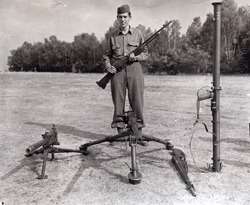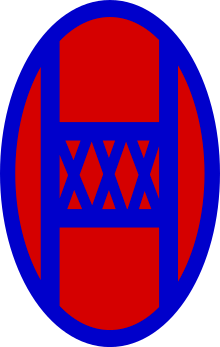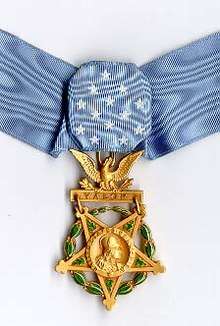Francis S. Currey
| Francis Sherman Currey | |
|---|---|
 Currey wearing his Medal of Honor in 1945 | |
| Born |
June 29, 1925 Loch Sheldrake, New York |
| Allegiance | United States of America |
| Service/ | United States Army |
| Years of service | 1943 - 1945 |
| Rank | Technical Sergeant |
| Unit | 3rd Battalion, 120th Infantry Regiment, 30th Infantry Division |
| Battles/wars |
World War II Battle of the Bulge |
| Awards |
Medal of Honor Silver Star Bronze Star Purple Heart (3) Belgian Order of Leopold |
Francis Sherman "Frank" Currey (born June 29, 1925) is a former United States Army technical sergeant and a recipient of the United States military's highest decoration for valor—the Medal of Honor—for his heroic actions in Belgium during the Battle of the Bulge, in World War II. He is one of four living Medal of Honor recipients of the war.
Biography
Currey was born in Loch Sheldrake, New York, on June 29, 1925. After being orphaned at age 12, he was raised by foster parents on a farm in nearby Hurleyville. He graduated from Hurleyville High School in June 1943.
He joined the Army at age 17, one week after leaving high school.[1] Although he completed Officer Candidate School, at only 18 years old, his superiors felt that he was "too immature" to be an officer and denied him a commission.[2]
After training with the 75th Infantry Division in Louisville and Kentucky, Currey was sent to England in July 1944; due to a recently signed executive order by President Franklin Roosevelt which prevented soldiers under age 19 from entering combat areas, Currey was delayed in the states until his birthday at the end of June.


Currey landed at Omaha Beach in July 1944, a few weeks after D-Day. In September, he was assigned as a replacement without winter gear (he later suffered from frostbite) to 3rd Platoon, K Company, 120th Infantry Regiment, 30th Infantry Division, in Netherlands.[2] He saw his first combat action that month. Six weeks later, he would be a sergeant and 3rd Platoon Leader in K Company. On December 21, 1944, Private First Class Currey was an automatic rifleman in a rifle squad which was guarding a bridge crossing and strongpoint. He repeatedly exposed himself to hostile fire while firing upon and killing several German infantrymen during an early morning German tank advance in Malmedy, Belgium. During the attack, he used a bazooka and anti-tank grenades which caused four enemy tank crews to abandon their tanks and also enabled him to rescue five comrades who had been pinned down in a building by enemy fire.[3] After the Battle of the Bulge, he became a squad leader, and was awarded the Silver Star for gallantry in action at his regiment's command post.
In March 1945, Currey's company commander recommended him for the Medal of Honor for his actions on 21 December. The Medal of Honor was presented to Currey on July 27, 1945, by the 30th Infantry Division division commander, Major General Leland Hobbs, near Reims, France;[4] the medal was officially awarded to him on August 17, 1945.[5] After the war was over in Europe, he received his 3rd Purple Heart for being shot in Bavaria while disarming German soldiers. He returned to the United States in August as a first sergeant after occupational duty and a stop in England aboard the Queen Mary.[6]
Currey worked as a counselor at the VA Medical Center in Albany, New York from 1950 until he retired as a supervisor, in 1980. After he retired from the VA, he started and ran a landscaping business. He also worked at a hotel booking conventions in Myrtle Beach, South Carolina, until 2002.[7]
Military awards
Currey's military awards and decorations:[8]
 | |||||||||||
| Army Meritorious Unit Commendation with one bronze oak leaf cluster |
Medal of Honor citation
Currey's official Medal of Honor citation reads:
Rank and organization: Sergeant, U.S. Army, Company K, 120th Infantry, 30th Infantry Division
Place and date: Malmedy, Belgium, 21 December 1944
Entered service at: Hurleyville, N.Y.
Birth: Loch Sheldrake, N.Y.
G.O. No. 69, 17 August 1945

He was an automatic rifleman with the 3rd Platoon defending a strong point near Malmedy, Belgium, on 21 December 1944, when the enemy launched a powerful attack. Overrunning tank destroyers and antitank guns located near the strong point, German tanks advanced to the 3rd Platoon's position, and, after prolonged fighting, forced the withdrawal of this group to a nearby factory. Sgt. Currey found a bazooka in the building and crossed the street to secure rockets meanwhile enduring intense fire from enemy tanks and hostile infantrymen who had taken up a position at a house a short distance away. In the face of small-arms, machinegun, and artillery fire, he, with a companion, knocked out a tank with 1 shot. Moving to another position, he observed 3 Germans in the doorway of an enemy-held house. He killed or wounded all 3 with his automatic rifle. He emerged from cover and advanced alone to within 50 yards of the house, intent on wrecking it with rockets. Covered by friendly fire, he stood erect, and fired a shot which knocked down half of 1 wall. While in this forward position, he observed 5 Americans who had been pinned down for hours by fire from the house and 3 tanks. Realizing that they could not escape until the enemy tank and infantry guns had been silenced, Sgt. Currey crossed the street to a vehicle, where he procured an armful of antitank grenades. These he launched while under heavy enemy fire, driving the tankmen from the vehicles into the house. He then climbed onto a half-track in full view of the Germans and fired a machinegun at the house. Once again changing his position, he manned another machine gun whose crew had been killed; under his covering fire the 5 soldiers were able to retire to safety. Deprived of tanks and with heavy infantry casualties, the enemy was forced to withdraw. Through his extensive knowledge of weapons and by his heroic and repeated braving of murderous enemy fire, Sgt. Currey was greatly responsible for inflicting heavy losses in men and material on the enemy, for rescuing 5 comrades, 2 of whom were wounded, and for stemming an attack which threatened to flank his battalion's position.[5]
Other honors
- In 1998, the first Medal of Honor G.I. Joe action figure was modeled after Currey.[1]
- Beginning July 2003, Hurleyville annually celebrates "Francis S. Currey Day" in July.
- In 2006, Currey became a member of the New York State Senate Veterans' Hall of Fame.[9][10]
- In 2013, an outside mural of Currey was unveiled in his honor as a living Medal of Honor recipient at the Sullivan Country Museum in Hurleyville.[11]
- In November 2013, Currey's photo was one of 12 photos of Medal of Honor recipients on the cover sheet of a U.S. Postal Service "World War II Medal of Honor Forever Stamp" packet of 20 Medal of Honor stamps.[12]
See also
References
![]()
- 1 2 Bedell, Barbara (July 14, 2006). "Event a tribute to Medal of Honor recipient". Times Herald-Record. Middletown, New York. Retrieved 2012-07-09.
- 1 2 Collier, Peter (2006). Medal of Honor: Portraits of Valor Beyond the Call of Duty. New York: Workman Publishing Company. p. 50. ISBN 978-1-57965-314-9.
- ↑
- ↑ Sullivan Country Democrat
- 1 2 "Medal of Honor recipients - World War II (A–F)". United States Army Center of Military History. June 8, 2009. Archived from the original on 2008-06-16. Retrieved 2009-06-09.
- ↑
- ↑ Sullivan Country Democrat
- ↑
- ↑
- ↑
- ↑ Sullivan Country Democrat
- ↑
External links
| Wikimedia Commons has media related to Francis S. Currey. |
- "Francis S. Currey". Hall of Valor. Military Times. Retrieved September 13, 2010.